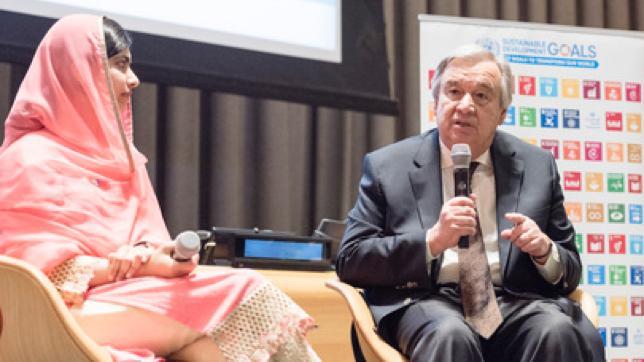Sustainability: A Moral Case Is Now a Business Case
By: Jason Small

We're all watching
On the highest balcony at the UN General Assembly, 193 young people fill the space as they stand holding solar-powered lanterns to symbolize their hope. Each represents the youth of a different country. All are here to witness world leaders gather to address the future sustainability of the world.
They came to send a powerful message on the importance of this agenda to the future, as these world leaders set out to commit to the 17 different Sustainable Development Goals (SDGs) by 2030.
Malala Yousafzai, education advocate and Co-founder of the Malala Fund, stands at the center of the balcony addressing the General Assembly.
“I watched from the floor in this powerful moment where these young people came to let world leaders know that this is a vote on their future,” recalls Kathy Calvin, president and CEO of the UN Foundation.
That was four years ago on September 25, 2015.
Not your grandfather’s UN
Calvin is a veteran of the corporate world with a history of successful executive roles. Before working with the UN, she saw it as an entity that worked on international politics and focused on humanitarian work. It was a fairly common impression at the time.
“Today, it’s not your grandfather’s UN,” shares Calvin during a recent interview with Verizon.
She has spent 17 years working with the UN and watched it evolve the way it approaches the work.
Now, the UN deliberately recruits collective effort from the private sector and conveys a key message while evangelizing the work: We need everyone’s help.
Standing up for goals that matter
When setting goals to change the world, how many do you need? That was just one of the many daunting questions that needed answered – and there was a deadline.
At the end of 2015 the former eight goals set in 2000, called the Millennium Development Goals (MDGs), would end. As great as those goals were, everyone knew the new goals needed to improve upon them.
Three big principles emerged to ensure the new goals would be an improved approach:
- They must belong to everyone. This time, they had to be universal and include every country in the world – developing and developed.
- Greater environmental focus. Reflect the social and economic challenges while increasing the emphasis on environmental challenges.
- Open the door to every part of society. The private sector, not just government, were invited in as part of the programmatic design and considered critical to implementation.
Technology had also come a long way since 2000. So, how do you address access to technology at a time when it’s inseparable from most everything?
Current Verizon CEO and Chairman, Hans Vestberg, was leading Ericcson at the time. Vestberg worked with the UN Foundation (and is now a Board member of the Foundation) and set out to create a stand-alone goal that highlighted the need for access to technology. But the importance became so great, the decision was made to embed access to technology as target indicators within the individual goals.
The final result of the overall multi-year effort generated 17 Sustainable Development Goals.
Calvin credits a considerable part of the successful widespread attention they’ve gotten to the decision to bring in creative help, including a designer. The designer created icons representing the SDGs. This made them more accessible than just having a resolution on paper.
Culture adds momentum
The SDGs have a target of 2030. In these first four years, Calvin has been inspired by a natural cultural movement: Consumers voting with their wallets.
As the next generation of society gained buying power, core values became apparent as many of them shared concern for sustainability on a global level. Additionally, their sense of altruism and being connected to a greater purpose stands out from previous generations. So they began to direct their buying power to brands that emulated these values -- and the private sector took notice.
Organizations worldwide expanded on building global sustainability efforts and societal wellness into their business models.
The UN Foundation helped outline the business case for sustainable development by supporting the efforts of the Business Commission on Sustainable Development to produce a report showcasing why sustainable development is now overtly in the best interest of companies.
While some private and public sector leaders are creating change, the situation demands more from all of us.
In a recent conversation for this article, Calvin emphasized the importance of an all-inclusive global effort when speaking about the SDGs. That means from the top down and from the bottom up.
The rise of local communities
Besides the new generation of consumers that vote with their wallet, Calvin has also seen a rise in localized ownership. When citizens feel not enough is being done by leadership in government or elsewhere, they are stepping up within their community -- organizing local efforts to support the SDGs.
This suggests that rather than the power of the individual -- perhaps it’s the power of the individual to unlock the potential of his or her community.
Imagine today is your 2030
The 17 SDGs have a deadline of 2030. Clearly, the UN Foundation has done the work to support the UN in making them global, ambitious and accountable.
But what if today were January 1, 2030? Are you content to let the future of the planet and society rest with the actions of others?
Make a decision now to get involved and make a difference.
Visit the UN Foundation and get involved.
For related media inquiries, please contact story.inquiry@one.verizon.com
About the author(s):
Jason Small focuses on storytelling for the Verizon communications team. His background includes online and offline roles in digital marketing and communications within corporate, agency and startup environments across more than 20 brands.

